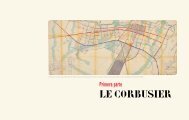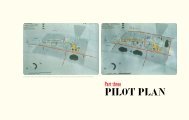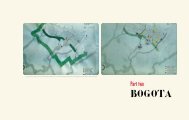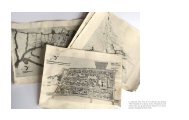parte 2 - Le Corbusier en Bogotá
parte 2 - Le Corbusier en Bogotá
parte 2 - Le Corbusier en Bogotá
Create successful ePaper yourself
Turn your PDF publications into a flip-book with our unique Google optimized e-Paper software.
<strong>Le</strong> <strong>Corbusier</strong>, maqueta del Palacio del gobernador, Chandigarh. En: <strong>Le</strong> <strong>Corbusier</strong>,<br />
Œuvre Complète, vol. 6, 1956-1957, p. 102. © FLC.<br />
Jaime Sarmi<strong>en</strong>to: arquitecto por la Universidad Nacional de Colombia, Medellín<br />
(1988), doctor por la Escuela Técnica Superior de Arquitectura de Barcelona,<br />
de la Universidad Politécnica de Cataluña (1997), con la tesis: La<br />
capilla de Ronchamp de <strong>Le</strong> <strong>Corbusier</strong>. Profesor de la Universidad Nacional<br />
de Colombia, Medellín (1993-2000) y de la Escuela de Arquitectura La<br />
Salle, de la Universidad Ramón Llull, Barcelona (2002-2009), donde también<br />
ha desempeñado los cargos de coordinador de Cultura (2003-2006)<br />
y responsable de Relaciones Internacionales (2007-2009). En paralelo a<br />
la doc<strong>en</strong>cia, ha desempeñado una labor como proyectista <strong>en</strong> Colombia<br />
y <strong>en</strong> España. Ha sido pon<strong>en</strong>te e invitado para dar confer<strong>en</strong>cias <strong>en</strong> varias<br />
universidades de Colombia y Europa. Ti<strong>en</strong>e publicaciones <strong>en</strong> libros y revistas<br />
internacionales. Actualm<strong>en</strong>te desarrolla una investigación <strong>en</strong> torno<br />
a un sistema de construcción modular, el cual ha sido registrado para una<br />
pat<strong>en</strong>te de inv<strong>en</strong>ción.<br />
1 Naïna Jornod y Jean-Pierre Jornod, <strong>Le</strong> <strong>Corbusier</strong>, Catalogue raisonné de<br />
l’oeuvre peint, Skira, 2007, p. 600.<br />
2 «En vérité la clef de ma création artistique est mon œuvre picturale <strong>en</strong>treprise<br />
<strong>en</strong> 1918 et poursuivie régulièrem<strong>en</strong>t chaque jour (...) <strong>Le</strong> fond de<br />
ma recherche et de ma production intellectuelles a son secret dans la<br />
pratique ininterrompue de la peinture. C’est là qu’il faut trouver la source<br />
de ma liberté d’esprit, de mon désintéressem<strong>en</strong>t, de l’indép<strong>en</strong>dance, de<br />
la loyauté et de l’intégrité de mon œuvre», <strong>en</strong> Jean Petit, <strong>Le</strong> <strong>Corbusier</strong>, luimême,<br />
Rousseau, Ginebra, 1970, p. 160.<br />
3 «La peinture est une bataille terrible, int<strong>en</strong>se, sans pitié, sans témoins: un<br />
duel <strong>en</strong>tre el artiste et lui-même. La bataille, est intérieure, dedans, inconnue<br />
au dehors. Si l’artiste la raconte c’est qu’il est un traitre vis à vis de lui<br />
même». En <strong>Le</strong> <strong>Corbusier</strong>, Carnets, Electa y FLC., Vol. 4, Graf. 506.<br />
4 Mog<strong>en</strong>s Krustrup, <strong>Le</strong> <strong>Corbusier</strong>, L’ilíade Dessins, Borg<strong>en</strong>, Cop<strong>en</strong>hague,<br />
1986, y <strong>Le</strong> <strong>Corbusier</strong>, Porte Email, Forlag, Cop<strong>en</strong>hague, 1991; Richard<br />
A. Moore, «<strong>Le</strong> <strong>Corbusier</strong>: Myth and meta architecture. The late period<br />
(1947-1965)», catálogo de la exposición <strong>Le</strong> <strong>Corbusier</strong> Images and Symbols,<br />
1977, y «Alchemical and Mythical Themes in the Poem of the Right<br />
Angle 1947-1965», Oppositions 19/20, 1987; Naïna Jornod y Jean-Pierre<br />
Jornod, óp. cit.<br />
5 Marie Cuttolli era una coleccionista de arte y a la vez t<strong>en</strong>ía un taller de tapicería<br />
<strong>en</strong> Aubusson. Había solicitado a varios artistas, <strong>en</strong>tre ellos <strong>Le</strong>ger,<br />
Picasso, Miró, Matisse, Braque y al propio <strong>Le</strong> <strong>Corbusier</strong> el poder trasladar<br />
algunos de sus cuadros a la tapicería.<br />
6 <strong>Le</strong> <strong>Corbusier</strong>, Œuvre Tissé, Philippe Sers, París, 1987, p. 14.<br />
7 «J’admets la fresque non pas pour mettre <strong>en</strong> valeur un mur, mais au contraire<br />
comme un moy<strong>en</strong> pour détruire tumultuesem<strong>en</strong>t le mur, lui <strong>en</strong>lever<br />
toute notion de stabilité, de poid, etc.» <strong>Le</strong> <strong>Corbusier</strong>, «<strong>Le</strong> passé a réaction<br />
poétique», catálogo de exposición. París: Caise nationale des Monum<strong>en</strong>ts<br />
historiques et de Sites/Ministère de la Culture et de la Communication,<br />
1988, p.75.<br />
8 Beatriz Colomina, «<strong>Le</strong> <strong>Corbusier</strong> y Eile<strong>en</strong> Gray: una casa de mala reputación»,<br />
<strong>en</strong>: Arquitectas, un reto profesional, memorias de las Jornadas<br />
Internacionales de Arquitectura y Urbanismo desde la Perspectiva de las<br />
Arquitectas, Instituto Juan de Herrera y Ministerio de la Vivi<strong>en</strong>da, C/A Gráfica,<br />
pp. 343-353.<br />
9 <strong>Le</strong> <strong>Corbusier</strong>, Œuvre Tissé, óp. cit., p. 15.<br />
10 «Permettez-moi d’ouvrir la f<strong>en</strong>être vers les horizons illimités de l’art».<br />
<strong>Le</strong> <strong>Corbusier</strong>, <strong>en</strong> Stanislaus von Moos, <strong>Le</strong> <strong>Corbusier</strong>, l’architecte et son<br />
mythe, Horizons de France, París, 1971, p. 272.<br />
11 «Ce tableau, d’où émanem<strong>en</strong>t une grande t<strong>en</strong>dresse et une douce quiétud,<br />
semble exprimer le portrair de ‘la famille’ de <strong>Le</strong> <strong>Corbusier</strong> (…) Yvonne<br />
se trouve sur le canapé, récemm<strong>en</strong>t acquis; l’animal est Pinceau, leur premier<br />
chi<strong>en</strong>, un griffon, reconnu à la frisure de ses poils», <strong>en</strong>: Naïna Jornod<br />
y Jean-Pierre Jornod, óp. cit. p. 573.<br />
12 Carta del 26 de noviembre de 1964 a l’abbé Reddat. Archivos FLC. Q(1)<br />
5, pp. 174.<br />
13 Peter Smithson, Conversaciones con estudiantes, G. G., p. 21.<br />
14 <strong>Le</strong> <strong>Corbusier</strong>, Œuvre Tissé, óp. cit., p. 14.<br />
15 Sobre la interpretación del Poema del ángulo recto, ver Richard A. Moore,<br />
«Alchemical and Mythical Themes in the Poem of the Right Angle 1947-<br />
1965», <strong>en</strong> Oppositions 19/20, 1987, pp. 110-139.<br />
16 Esta litografía puede ser considerada como la «pasada a limpio» del último<br />
de los bocetos que sirvieron <strong>en</strong> el proceso de transformación del<br />
bodegón a la figura del toro, m<strong>en</strong>cionado anteriorm<strong>en</strong>te.<br />
17 De hecho, <strong>Le</strong> <strong>Corbusier</strong> utilizó la imag<strong>en</strong> del cuervo como una especie de<br />
firma personal. En las pinturas de la puerta ceremonial del Capitolio de<br />
Chandigarh, intercalado con su firma <strong>en</strong> letras, pintó el cuervo como su<br />
id<strong>en</strong>tidad gráfica.<br />
18 <strong>Le</strong> <strong>Corbusier</strong> secret: dessins et collages de la collection Ahr<strong>en</strong>berg, Lausanne:<br />
Musée Cantonal des Beaux-Arts, 1987.<br />
19 Richard Moore, «<strong>Le</strong> <strong>Corbusier</strong>: Myth and meta architecture. The late period<br />
(1947-1965)», óp. cit. Trata sobre la interpretación del mural <strong>en</strong> el pabellón<br />
suizo.<br />
20 «(…) <strong>Le</strong> <strong>Corbusier</strong> stood the base on its head as if he wanted to transfer its<br />
attributes to himself and make the perspective of Pegasus his own». Mateo<br />
Kries, «S, M, L, XL: Metamorphoses of the Ori<strong>en</strong>t in the work of <strong>Le</strong> <strong>Corbusier</strong>»,<br />
<strong>en</strong> <strong>Le</strong> <strong>Corbusier</strong> – The art of architecture, Vitra Design Museum, The<br />
Netherlands Architecture Institute y RIBA, 2007, p. 184-185.<br />
21 <strong>Le</strong> <strong>Corbusier</strong>, Carnets, Electa / FLC., Hrescher / dessain et Tolra, París,<br />
1982–1984, Vol. II, F-24, Graf. 701, 703 y 707.<br />
22 «I was impressed by the natural conc<strong>en</strong>tration of the simple ritual expressed<br />
in the gesture of her hands with fingers interwov<strong>en</strong>, the low table with<br />
candles and the broad forms of her chest and head frankly staring at the<br />
invisible object of her faith». <strong>Le</strong> <strong>Corbusier</strong>, <strong>en</strong> Richard Ingersoll, <strong>Le</strong> <strong>Corbusier</strong>,<br />
A Marriage of countours, Princeton Architectural Press, Nueva York,<br />
1990, p. 12.<br />
23 Jean Petit, <strong>Le</strong> <strong>Corbusier</strong>: Lui-même, Rousseau, G<strong>en</strong>ève, 1970, p. 121.<br />
Ver también Jaime Coll, <strong>Le</strong> <strong>Corbusier</strong>: la forma acústica, tesis doctoral<br />
ETSAB - Universidad Politécnica de Cataluña, 1994. Se trata de un estudio<br />
sobre la producción pictórica de <strong>Le</strong> <strong>Corbusier</strong>.<br />
24 Richard Moore, <strong>Le</strong> <strong>Corbusier</strong>. Myth and Meta Architecture. The late period<br />
(1947-1965), óp. cit.<br />
25 Esta litografía de Femme Rose <strong>en</strong>tronca con la serie de pinturas Deux<br />
Femmes de mediados de los años treinta, <strong>en</strong> la que una de las dos mujeres<br />
ti<strong>en</strong>e el rostro de la luna y al fondo se aprecia la V<strong>en</strong>tana.<br />
26 Esta relación <strong>en</strong>tre Pasiphae y el toro también se puede constatar <strong>en</strong> la<br />
litografía del Poema, titulada Unite I, <strong>en</strong> la que una mujer se abraza con<br />
un toro.<br />
27 Mog<strong>en</strong>s Kustrup, l’Iliade de le <strong>Corbusier</strong>, Editrice Abitare Segesta, Milano,<br />
2000, y Mog<strong>en</strong>s Kustrup, <strong>Le</strong> <strong>Corbusier</strong>, L’Ilíade Dessins, Borg<strong>en</strong>,<br />
Cop<strong>en</strong>hague, 1986.<br />
28 «Cap Martin 21/2/55. Cette édition me dégoûte! La typo est bête, les illustrations<br />
nous plong<strong>en</strong>t au gouffre le plus noir de l’académisme. Art des<br />
Olympes pour professeurs et bicornes d’Institut. Grèce non-combattante,<br />
verbeuse, <strong>en</strong> fauteuil et pantoufles. Pas une seul signe de vie. Homère<br />
est assassiné. J’ai le s<strong>en</strong>tim<strong>en</strong>t que la traduction est néfaste, lugubree.»<br />
Mog<strong>en</strong>s Kustrup, l’Iliade de le <strong>Corbusier</strong>, óp. cit., p. 71.<br />
29 Naïna Jornod y Jean-Pierre Jornod, óp. cit., p. 870-871.<br />
30 <strong>Le</strong> <strong>Corbusier</strong> com<strong>en</strong>taba que la cubierta de la capilla estuvo inspirada <strong>en</strong><br />
una concha de cangrejo que recogió mi<strong>en</strong>tras caminaba por las playas<br />
de Long-Island: «Une coque de crabe ramassée à Long-Island près New<br />
York, <strong>en</strong> 1946, est posée sur la table à dessin. Elle devi<strong>en</strong>dra le toit de la<br />
Chapelle...», <strong>en</strong> <strong>Le</strong> <strong>Corbusier</strong>, Ronchamp, Hatje, Stuttgart, 1957, p. 89.<br />
31 <strong>Le</strong> <strong>Corbusier</strong>, <strong>en</strong> <strong>Le</strong> <strong>Corbusier</strong>. Œuvre Complète, Willy Boesiger (Dir.), <strong>Le</strong>s<br />
Editions d’Architecture / Artemis, Zúrich, 1929-1969, Vol. 8, p. 169.<br />
32 <strong>Le</strong> <strong>Corbusier</strong>, Precisions, Apóstrofe, Barcelona, 1999, p. 98.<br />
33 <strong>Le</strong> <strong>Corbusier</strong>, Carnets, óp. cit., Vol. II, E-20, Graf. 430 y 431.<br />
<strong>Bogotá</strong>: el mural nómada que pinto <strong>Le</strong> <strong>Corbusier</strong> | Jaime Sarmi<strong>en</strong>to<br />
135







